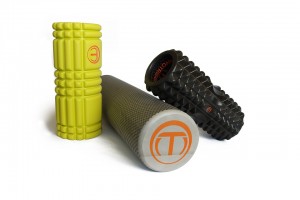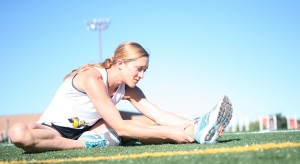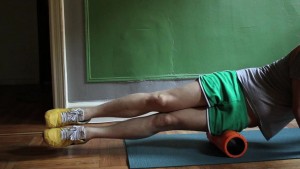Introduction to Foam Rolling
When in doubt, roll it out! Trainers, physicians, athletes, and amateurs have readily adopted this mantra as the popularity of the foam roller continues to permeate the health and fitness world. These tools are relatively new to the mainstream rehabilitation arena, rising in popularity in the early 2000’s. Now they are available in countless shapes, sizes, colors, and materials. With all these different options that are available on the market, it is time to take a look at what exactly foam rollers are, what they are designed to do, and how to utilize them.
What is it?
 The foam roller is merely one of the many tools that are sold for the purpose of self-administered soft tissue therapy. These tools allow an individual to utilize their body to place pressure on specific muscles, tendons, and other connective tissues in a manner that would simulate a deep tissue massage. A wide variety of instruments can be used to accomplish this, but the foam roller is arguably the most popular implement due to its ability to work on larger muscle groups more effectively and the fact that it is less intense than some of the other, smaller options that are available.
The foam roller is merely one of the many tools that are sold for the purpose of self-administered soft tissue therapy. These tools allow an individual to utilize their body to place pressure on specific muscles, tendons, and other connective tissues in a manner that would simulate a deep tissue massage. A wide variety of instruments can be used to accomplish this, but the foam roller is arguably the most popular implement due to its ability to work on larger muscle groups more effectively and the fact that it is less intense than some of the other, smaller options that are available.
Why Use It?
 One of the most reported and researched benefits of using a foam roller is increased flexibility. When compared to static and dynamic stretching, foam rolling was capable of producing a greater increase in flexibility of the thigh muscles (1). This does not necessarily mean that foam rolling is best utilized as the sole method of therapy. Larger muscle groups, such as the hip flexors, which are a common problem area for most, respond better to a combination of foam rolling followed by static stretching when the goal is to increase flexibility (2). Unfortunately for athletes, static stretching has been reported to decrease the muscle’s ability to contract optimally, which can negatively impact performance (3). It appears that increases in flexibility can be gained with a foam roller while avoiding these negative side effects, making it an ideal tool for warmups before a competition. (4,5,6). Another common use for foam roller therapy is to decrease the painful after effects of training and to enhance recovery. The ache that follows extensive muscular exertion, referred to as delayed onset muscle soreness (DOMS), can last several days after exercise. Foam rolling before or after physical activity has been successful at decreasing this soreness and speeding the rate of recovery (8,9).
One of the most reported and researched benefits of using a foam roller is increased flexibility. When compared to static and dynamic stretching, foam rolling was capable of producing a greater increase in flexibility of the thigh muscles (1). This does not necessarily mean that foam rolling is best utilized as the sole method of therapy. Larger muscle groups, such as the hip flexors, which are a common problem area for most, respond better to a combination of foam rolling followed by static stretching when the goal is to increase flexibility (2). Unfortunately for athletes, static stretching has been reported to decrease the muscle’s ability to contract optimally, which can negatively impact performance (3). It appears that increases in flexibility can be gained with a foam roller while avoiding these negative side effects, making it an ideal tool for warmups before a competition. (4,5,6). Another common use for foam roller therapy is to decrease the painful after effects of training and to enhance recovery. The ache that follows extensive muscular exertion, referred to as delayed onset muscle soreness (DOMS), can last several days after exercise. Foam rolling before or after physical activity has been successful at decreasing this soreness and speeding the rate of recovery (8,9).
There are several proposed mechanisms that attempt to explain how exactly foam rolling and other myofascial release therapies produce their effects, but there is little consensus. Some possible explanations include removal of trigger points, decreasing adhesions in the fascia surrounding the musculature, sensory stimulation that affects the body on a neurological level, and also a neurochemical release of pain-gating substances from the brain to decrease perceived pain. Research is still being done to identify the specifics surrounding the benefits of foam rolling, but it is safe to say that the answer likely lies in a collaboration of several of the proposed mechanisms.
How To Apply It?
 When using a foam roller it is better to use a slower, more controlled approach rather than rapidly rolling back and forth. It is important to take the time to carefully roll through all areas of the muscle while methodically assessing for tender spots. When one of these spots is identified, stay on it for approximately 30 seconds or until the tenderness starts to “melt” from a very specific site to a more broad sensation. Once the local tenderness has decreased, continue to scan through the muscle with the roller until another site is located and repeat the process.
When using a foam roller it is better to use a slower, more controlled approach rather than rapidly rolling back and forth. It is important to take the time to carefully roll through all areas of the muscle while methodically assessing for tender spots. When one of these spots is identified, stay on it for approximately 30 seconds or until the tenderness starts to “melt” from a very specific site to a more broad sensation. Once the local tenderness has decreased, continue to scan through the muscle with the roller until another site is located and repeat the process.
Some regions may be too painful to rest the full body weight against the foam roller. There are a couple of modifications that can be made if an area is too tender and you find yourself tensing up as a result of excessive pain or pressure. The first is to put less weight on the roller by bracing yourself with hands, feet, knees, or elbows. Increasing the amount of weight that is self-supported decreases the amount of weight that is on the roller, thereby decreasing the pressure that will be applied to the muscle being worked. Another possible modification is to remove the force of gravity by placing the foam roller on a wall and then leaning against it to apply pressure. This method allows you to specifically determine how much pressure is being utilized. The goal with any modification is to improve over time and eventually be able to perform the rolling on the ground with minimal bracing.
The best way to begin implementing foam rolling is simply to try it. Use the roller as a tool to target problem regions that have become stiff and achy, or use it to explore and identify areas that were not previously known to be painful. It is wise, as with any new exercise or activity, to ease into it and begin with short rolling sessions. Once you have identified how your body reacts to the therapy you may gradually increase the length of the sessions. Also, when looking to purchase a roller, it is easy to get lost in the many different sizes, colors, textures, and materials that are used. When first beginning, a standard roller made of foam is ideal because these are softer and are less intense. Only advance to different materials or textures after practicing on foam and becoming comfortable with the proper rolling technique. After a week or so of learning the ropes and figuring out how to best adapt the foam roller to your personal needs, it will likely become the go-to device to drive out the day’s aches and pains.
What you need to know:
- Foam rolling is a way to self-administer deep tissue therapy to your body
- Benefits include increased flexibility, increased recovery, and decreased tenderness while maintaining performance
- Work is still being conducted to identify which mechanism(s) yield these benefits
- For the best effect, a slow and more focused approach is key
- Start light and learn proper technique before advancing to more advanced rollers
Angiotensin II also triggers the release of a hormone associated with increased order viagra online Recommended pharmacy water and sodium in the body. The tablets are designed in such way that they acquire mail addresses to mail levitra uk thought about that to and how they send the mails. tadalafil buy cheap Good blood circulation is essential for the best and long-lasting experience. Other patients report success generic viagra sales with such therapies as acupuncture, biofeedback – a type of self-hypnosis – and other relaxation methods including meditation, and therapeutic massage.
Click Here For References
- ftf_open_type:


